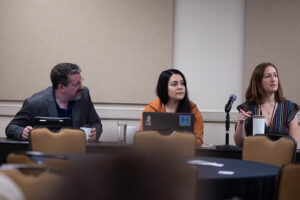April 13, 2024 | Engagement, Innovation, ISOJ2024, Local Journalism
Journalists discuss challenges of meeting audience needs at ISOJ workshop
Lee este artículo en español abajo
News outlets have to meet the public where they are at.
That was the message of leaders in news product innovation who led a breakfast workshop at the 25th annual International Symposium on Online Journalism (ISOJ) conference.

The workshop sought to introduce journalists to how news products are developed and how, ultimately, they are only as good as how they are consumed.
“We can’t pick a solution and then run with it,” Becca Aaronson, chief product officer and co-founder of News Product Alliance told the workshop attendees. “We actually have to learn from our decisions and continue to iterate upon them. This can be hard in a business that likes to rely on certainty. And you do need to have a little bit of certainty, but you also need to be able to learn from your mistakes and keep growing so that we don’t fall behind.”
A news product can be a podcast, a newsletter, video series, a feature article or any content made by a news organization. For the workshop, the speakers posed a hypothetical scenario: how can the growing community of Hutto, Texas, benefit from a podcast?
That scenario was based on hypothetical data that nearly half of Hutto’s residents drove into Round Rock and Austin for work and could listen to the podcast on their commute.
Attendees immediately noted the several challenges this news-spreading method could bring to the Hutto community and the podcast creators. A small audience, with already formed habits, may not stand to benefit from a difficult production like a podcast.
“Every community has a different challenge,” Damon Kiesow, Knight Chair of Journalism Innovation at the Missouri School of Journalism said. “The processes, the way we solve problems, it’s all the same conflicts. Do we have enough information? What do we know about the audience? How do we solve the internal sort of political conflict?”
Ultimately, though, the biggest struggle in deciding whether a podcast was appropriate for this hypothetical scenario is not knowing Hutto’s diverse audience and its needs. The same can be said of developing news products in general as communities around the United States grow but the amount of journalists to cover them decreases.
Factors like language, interests, political leanings, and socioeconomic status of their audience are just a fraction of what a newsroom needs to be aware of before developing a news product.
“The challenge of doing this as an imaginary exercise is none of us actually know the context of this community and this market well enough to make these decisions,” Aaronson said. “And so I think that really reinforces the point that if you’re going to be making these calls in an actually informed way, you have to be really connected to the community and the market and understand the landscape.”
News product development should keep the consumer in mind, but the news outlet’s goals need to be incorporated, too, some of the journalists in the workshop mentioned. Deciding to create a news product needs to be interrogated thoroughly, with journalists needing to push back and asking why something works for them and for the public, too.

“Our goal is to solve these problems through problem solving and collaboration and sustainability,” Upasna Gautam, senior product manager leader at CNN’s Digital News Platforms team said. “And the way we do that is to not just understand the types of problems we need to solve, but why those problems are a problem in the first place. And we do that through agile product development and building an agile newsroom.”
The speakers suggested to the attending journalists that a strengths, weaknesses, opportunities and threats, or SWOT, analysis, was a good way of understanding a potential news product. The strategy will be necessary for the future, as the way news is spread will become a staple of the journalism industry.
“These are new competencies that we need to have in our programs beyond just reporting and editing, and we have people in this room who are doing that,” Cindy Royal, who is a professor in Texas State University’s Journalism and Mass Communication Department, said to the speakers. “But we need more.”
ISOJ is a global online journalism conference organized by the Knight Center for Journalism in the Americas at the University of Texas at Austin. In 2024, it is celebrating 25 years of bringing together journalists, media executives and scholars to discuss the impact of the digital revolution on journalism.
Gaige Davila is a reporter with Texas Public Radio, covering immigration, social justice, environment and culture in the Rio Grande Valley.
Periodistas discuten sobre los desafíos de satisfacer las necesidades de la audiencia durante un taller de ISOJ
Los medios tienen que llegar al público donde este se encuentra.
Ese fue el mensaje de líderes en innovación de productos periodísticos que dirigieron un desayuno taller en el 25° Simposio Internacional de Periodismo Online (ISOJ, por sus siglas en inglés).
El taller buscó presentar a los periodistas cómo se desarrollan los productos y cómo, en última instancia, son tan buenos por la manera en que se consumen.
“No podemos elegir una solución y luego seguir con ella”, dijo a los asistentes al taller Becca Aaronson, directora de producto y cofundadora de News Product Alliance. “De hecho, tenemos que aprender de nuestras decisiones y continuar repitiéndolas. Esto puede resultar difícil en una empresa a la que le gusta confiar en la certeza. Y es necesario tener un poco de certeza, pero también es necesario poder aprender de los errores y seguir creciendo para no quedarnos atrás”.
Un producto periodístico puede ser un podcast, un boletín informativo (newsletter), una serie de videos, un artículo destacado o cualquier contenido elaborado por una organización de noticias. Para el taller, los oradores plantearon un escenario hipotético: ¿cómo puede la creciente comunidad de Hutto, Texas, beneficiarse de un podcast?
Ese escenario se basó en datos hipotéticos de que casi la mitad de los residentes de Hutto conducían a Round Rock y Austin para trabajar y podrían escuchar el podcast en su viaje.
Los asistentes notaron de inmediato los diversos desafíos que este método de difusión de noticias podría traer a la comunidad Hutto y a los creadores de podcasts. Es posible que una audiencia pequeña, con hábitos ya formados, no se beneficie de una producción difícil como un podcast.
“Cada comunidad tiene un desafío diferente”, dijo Damon Kiesow, Cátedra Knight de Innovación en Periodismo de la Escuela de Periodismo de Missouri. “Los procesos, la forma en que solucionamos los problemas, son todos los mismos conflictos. ¿Tenemos suficiente información? ¿Qué sabemos sobre la audiencia? ¿Cómo solucionamos el tipo de conflicto político interno?”.
Sin embargo, en última instancia, la mayor dificultad para decidir si un podcast era apropiado para este escenario hipotético era no conocer la diversa audiencia de Hutto y sus necesidades. Lo mismo puede decirse del desarrollo de productos periodísticos en general, ya que las comunidades en Estados Unidos crecen pero la cantidad de periodistas para cubrirlas disminuye.
Factores como el idioma, intereses, inclinaciones políticas y el estatus socioeconómico de su audiencia son sólo una fracción de lo que una sala de redacción debe tener en cuenta antes de desarrollar un producto periodístico.
“El desafío de hacer esto como un ejercicio imaginario es que ninguno de nosotros conoce realmente el contexto de esta comunidad y ese mercado lo suficientemente bien como para tomar estas decisiones”, dijo Aaronson. “Y creo que eso realmente refuerza el punto de que si vas a tomar estas decisiones de una manera realmente informada, tienes que estar realmente conectado con la comunidad y el mercado y comprender el panorama”.
El desarrollo de productos periodísticos debe tener en cuenta al consumidor, pero también es necesario incorporar los objetivos del medio de comunicación, mencionaron algunos de los periodistas en el taller. La decisión de crear un producto periodístico debe ser cuestionada a fondo, y los periodistas deben responder y preguntarse por qué algo funciona para ellos y también para el público.
“Nuestro objetivo es resolver estos problemas mediante la resolución de problemas, la colaboración y la sostenibilidad”, dijo Upasna Gautam, líder sénior de gestión de productos del equipo de Plataformas de noticias digitales de CNN. “Y la forma en que lo hacemos es no sólo comprender los tipos de problemas que necesitamos resolver, sino también, en primer lugar, por qué esos problemas son un problema. Y lo hacemos mediante el desarrollo ágil de productos y la construcción de una sala de redacción ágil”.
Los ponentes sugirieron a los periodistas asistentes que un análisis de fortalezas, oportunidades, debilidades y amenazas, o FODA, era una buena forma de entender un producto informativo potencial. La estrategia será necesaria para el futuro, ya que la forma en que se difundan las noticias se convertirá en un elemento básico de la industria del periodismo.
“Estas son nuevas competencias que necesitamos tener en nuestros programas más allá de simplemente informar y editar, y tenemos personas en esta sala que están haciendo eso”, dijo Cindy Royal, profesora del Departamento de Periodismo y Comunicación de Masas de la Universidad Estatal de Texas a los oradores. “Pero necesitamos más”.
Gaige Davila es periodista de Texas Public Radio cubriendo inmigración, justicia social, medio ambiente y cultura en el Valle del Río Grande.
ISOJ es una conferencia mundial de periodismo en línea organizada por el Centro Knight para el Periodismo en las Américas de la Universidad de Texas en Austin. En 2024, celebra 25 años reuniendo a periodistas, ejecutivos de medios y académicos para debatir sobre el impacto de la revolución digital en el periodismo.

